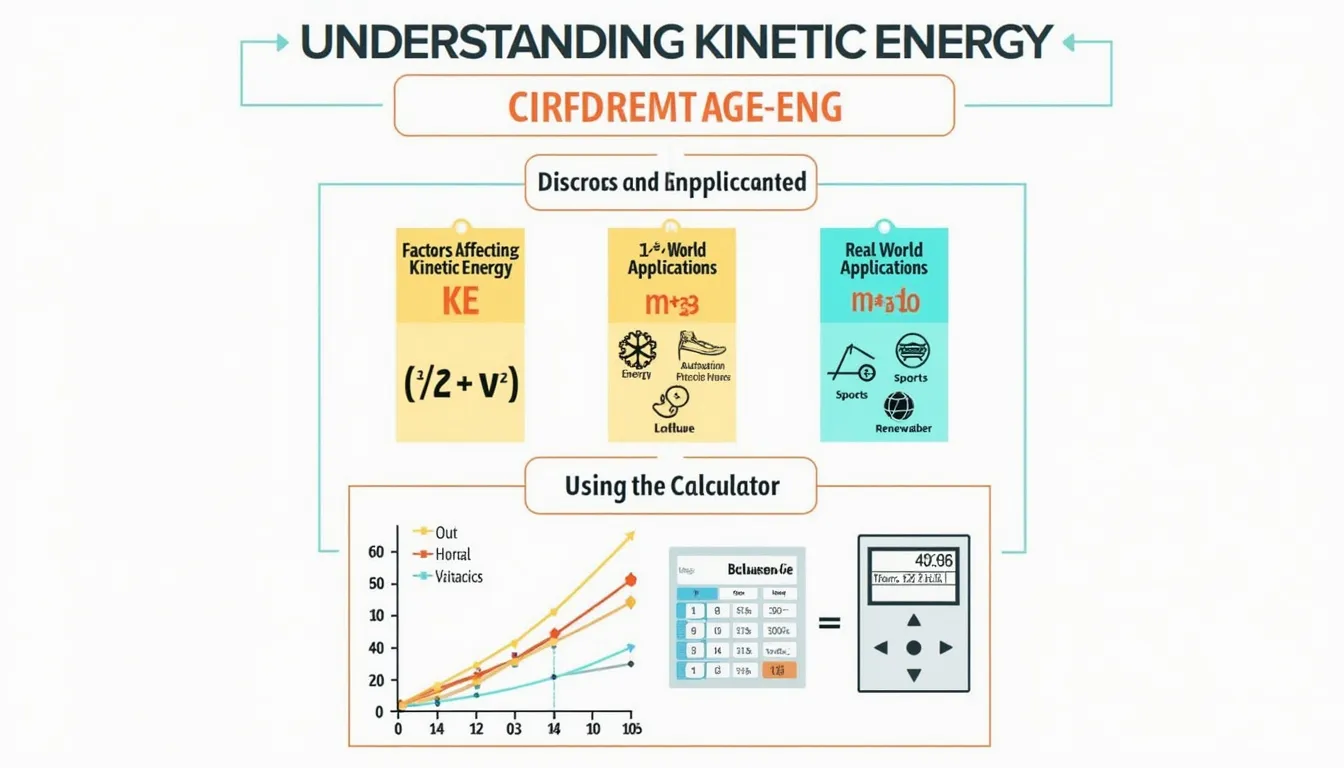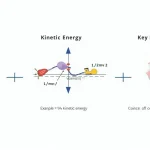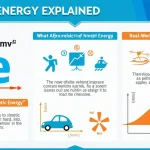Kinetic Energy Calculator
Is this tool helpful?
How to Use the Kinetic Energy Calculator Effectively
Our Kinetic Energy Calculator is designed to help you quickly and accurately determine the kinetic energy of an object based on its mass and velocity. Follow these simple steps to use the calculator effectively:
- Enter the mass: Input the mass of the object in the “Mass” field. For example, you might enter “10” for a 10-kilogram object.
- Select mass unit: Choose the appropriate unit for the mass from the dropdown menu (kg, g, or lb).
- Enter the velocity: Input the speed of the object in the “Velocity” field. For instance, you could enter “5” for an object moving at 5 meters per second.
- Select velocity unit: Choose the appropriate unit for the velocity from the dropdown menu (m/s, km/h, or mph).
- Calculate: Click the “Calculate Kinetic Energy” button to obtain the results.
- View results: The calculator will display the kinetic energy in joules (J), kilojoules (kJ), and calories (cal).
Remember, for accurate results, ensure that you input positive values for both mass and velocity.
Understanding Kinetic Energy: Definition, Purpose, and Benefits
Kinetic energy is a fundamental concept in physics that describes the energy possessed by an object due to its motion. It is directly proportional to both the mass of the object and the square of its velocity. Understanding and calculating kinetic energy is crucial in various fields, including physics, engineering, and sports science.
The Mathematical Formula for Kinetic Energy
The kinetic energy (KE) of an object is calculated using the following formula:
$$ KE = \frac{1}{2} \times m \times v^2 $$Where:
- KE is the kinetic energy in joules (J)
- m is the mass of the object in kilograms (kg)
- v is the velocity of the object in meters per second (m/s)
Purpose of the Kinetic Energy Calculator
The primary purpose of our Kinetic Energy Calculator is to simplify and streamline the process of calculating kinetic energy. It eliminates the need for manual calculations, reducing the likelihood of errors and saving valuable time. This tool is particularly useful for:
- Students studying physics or engineering
- Educators preparing lesson plans or demonstrations
- Scientists and researchers analyzing motion and energy
- Engineers designing systems involving moving objects
- Sports scientists optimizing athletic performance
Benefits of Using the Kinetic Energy Calculator
Utilizing our Kinetic Energy Calculator offers numerous advantages:
- Accuracy: The calculator eliminates human error in manual calculations, ensuring precise results.
- Time-saving: Obtain instant results without the need for lengthy manual computations.
- Versatility: Input mass and velocity in various units, with automatic conversions handled by the calculator.
- Multiple output units: View results in joules, kilojoules, and calories for comprehensive understanding.
- User-friendly interface: The intuitive design makes it easy for users of all levels to calculate kinetic energy.
- Educational value: Helps reinforce understanding of kinetic energy concepts through practical application.
- Accessibility: Available online, allowing for calculations anytime and anywhere with internet access.
Addressing User Needs and Solving Specific Problems
Our Kinetic Energy Calculator addresses several key user needs and solves specific problems related to understanding and working with kinetic energy:
1. Simplifying Complex Calculations
Calculating kinetic energy manually can be time-consuming and prone to errors, especially when dealing with large numbers or multiple unit conversions. Our calculator streamlines this process, allowing users to obtain accurate results quickly and effortlessly.
2. Handling Unit Conversions
One of the challenges in calculating kinetic energy is dealing with different units of mass and velocity. Our calculator incorporates built-in unit conversions, allowing users to input values in their preferred units without the need for manual conversion.
Example Calculation with Unit Conversion:
Let’s calculate the kinetic energy of a car with a mass of 1500 kg traveling at 100 km/h:
- Enter mass: 1500
- Select mass unit: kg
- Enter velocity: 100
- Select velocity unit: km/h
The calculator will automatically convert 100 km/h to approximately 27.78 m/s and perform the calculation:
$$ KE = \frac{1}{2} \times 1500 \times 27.78^2 \approx 578,704 \text{ J} \approx 578.7 \text{ kJ} \approx 138,313 \text{ cal} $$3. Providing Multiple Energy Units
Different fields and applications may require kinetic energy to be expressed in various units. Our calculator addresses this need by providing results in joules, kilojoules, and calories, eliminating the need for additional conversions.
4. Facilitating Comparative Analysis
By allowing quick and easy calculations, our tool enables users to compare the kinetic energy of different objects or the same object at different velocities, facilitating analysis and decision-making in various applications.
Example Comparative Analysis:
Let’s compare the kinetic energy of two vehicles:
- Vehicle A: Mass = 1200 kg, Velocity = 60 km/h
- Vehicle B: Mass = 800 kg, Velocity = 90 km/h
Using the calculator for each vehicle:
Vehicle A:
- KE ≈ 166,667 J ≈ 166.7 kJ ≈ 39,834 cal
Vehicle B:
- KE ≈ 250,000 J ≈ 250.0 kJ ≈ 59,752 cal
This quick comparison reveals that despite having a lower mass, Vehicle B has higher kinetic energy due to its greater velocity, demonstrating the significant impact of velocity on kinetic energy.
Practical Applications and Use Cases
The Kinetic Energy Calculator has a wide range of practical applications across various fields. Here are some examples illustrating its usefulness:
1. Automotive Engineering
Automotive engineers use kinetic energy calculations to:
- Design effective braking systems
- Analyze vehicle crash dynamics
- Optimize fuel efficiency
Example:
An engineer is designing a braking system for a 1500 kg car with a top speed of 200 km/h. Using the calculator, they can determine the maximum kinetic energy the brakes must dissipate:
KE ≈ 2,314,815 J ≈ 2,314.8 kJ
This information helps in selecting appropriate materials and designing the brake system to safely bring the vehicle to a stop.
2. Sports Science
Sports scientists and coaches use kinetic energy calculations to:
- Analyze the impact force in contact sports
- Optimize equipment design
- Improve athlete performance
Example:
A sports scientist is analyzing the impact of a 100 kg rugby player running at 8 m/s. Using the calculator:
KE = 3,200 J = 3.2 kJ
This information can be used to design protective gear or develop training programs to enhance player safety and performance.
3. Renewable Energy
In the field of renewable energy, kinetic energy calculations are crucial for:
- Designing wind turbines
- Optimizing hydroelectric power systems
- Developing tidal energy technologies
Example:
An engineer is assessing the potential energy output of a wind turbine. Assuming a mass of air of 1000 kg passing through the turbine at 15 m/s:
KE = 112,500 J = 112.5 kJ
This calculation helps in estimating the maximum theoretical energy that could be harvested from the wind under these conditions.
4. Ballistics and Forensics
In ballistics and forensic science, kinetic energy calculations are used to:
- Analyze bullet impacts
- Reconstruct accident scenarios
- Design protective equipment
Example:
A forensic scientist is analyzing the impact of a 10-gram bullet traveling at 350 m/s:
KE ≈ 612.5 J
This information can be used to assess potential damage, penetration depth, or the effectiveness of protective gear.
5. Space Exploration
In space exploration and astronomy, kinetic energy calculations are essential for:
- Planning spacecraft trajectories
- Designing re-entry systems
- Analyzing asteroid impacts
Example:
An astronomer is calculating the kinetic energy of a 1000 kg satellite orbiting Earth at 7.8 km/s:
KE ≈ 30,420,000 kJ
This calculation is crucial for understanding the satellite’s orbit and planning any potential maneuvers or de-orbiting procedures.
Frequently Asked Questions (FAQ)
Q1: What is kinetic energy?
A1: Kinetic energy is the energy possessed by an object due to its motion. It depends on both the mass of the object and its velocity. The faster an object moves or the more massive it is, the more kinetic energy it has.
Q2: Why is kinetic energy important?
A2: Kinetic energy is a fundamental concept in physics and has numerous practical applications. It helps us understand and quantify the energy of moving objects, which is crucial in fields such as engineering, sports science, and renewable energy.
Q3: Can kinetic energy be negative?
A3: No, kinetic energy cannot be negative. Since it’s calculated using the square of velocity, the result is always positive or zero (when the object is at rest).
Q4: How does mass affect kinetic energy?
A4: Kinetic energy is directly proportional to mass. This means that if you double the mass of an object while keeping its velocity constant, its kinetic energy will also double.
Q5: How does velocity affect kinetic energy?
A5: Kinetic energy is proportional to the square of velocity. This means that doubling the velocity of an object will quadruple its kinetic energy, making velocity a more significant factor than mass in determining kinetic energy.
Q6: What are some real-world applications of kinetic energy?
A6: Kinetic energy has numerous applications, including:
- Designing vehicle braking systems
- Optimizing sports equipment and techniques
- Developing renewable energy technologies like wind turbines
- Analyzing impacts in forensics and ballistics
- Planning space missions and satellite orbits
Q7: How is kinetic energy related to work?
A7: The work-energy theorem states that the work done on an object is equal to the change in its kinetic energy. This relationship is fundamental in understanding how forces affect the motion of objects.
Q8: Can kinetic energy be converted to other forms of energy?
A8: Yes, kinetic energy can be converted to other forms of energy and vice versa. For example, when a car brakes, its kinetic energy is converted to heat energy through friction. In a hydroelectric dam, the potential energy of water is converted to kinetic energy as it falls, which is then converted to electrical energy.
Q9: How does the Kinetic Energy Calculator handle different units?
A9: Our Kinetic Energy Calculator includes built-in unit conversions. You can input mass in kilograms, grams, or pounds, and velocity in meters per second, kilometers per hour, or miles per hour. The calculator automatically converts these to the standard units (kg and m/s) before performing the calculation.
Q10: Why does the calculator show results in different energy units?
A10: We provide results in joules (J), kilojoules (kJ), and calories (cal) to cater to different user needs and applications. Joules are the standard SI unit for energy, kilojoules are often used for larger energy values, and calories are commonly used in fields like nutrition and exercise science.
By addressing these common questions, we hope to enhance your understanding of kinetic energy and how to effectively use our Kinetic Energy Calculator. Whether you’re a student, educator, or professional, this tool can significantly simplify your calculations and deepen your insights into the fascinating world of motion and energy.
Important Disclaimer
The calculations, results, and content provided by our tools are not guaranteed to be accurate, complete, or reliable. Users are responsible for verifying and interpreting the results. Our content and tools may contain errors, biases, or inconsistencies. We reserve the right to save inputs and outputs from our tools for the purposes of error debugging, bias identification, and performance improvement. External companies providing AI models used in our tools may also save and process data in accordance with their own policies. By using our tools, you consent to this data collection and processing. We reserve the right to limit the usage of our tools based on current usability factors. By using our tools, you acknowledge that you have read, understood, and agreed to this disclaimer. You accept the inherent risks and limitations associated with the use of our tools and services.







